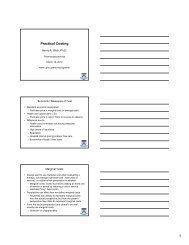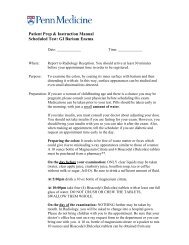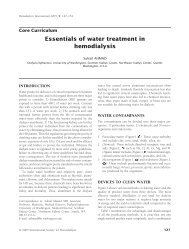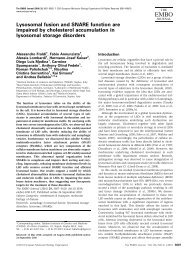Building a Treeage Markov Model
Building a Treeage Markov Model
Building a Treeage Markov Model
Create successful ePaper yourself
Turn your PDF publications into a flip-book with our unique Google optimized e-Paper software.
Preferences/Calculation/Calculation Method/Cost Effectiveness/ Cost Payoff 1, Effectiveness Payoff<br />
2/OK.”<br />
15. Perform a cost-effectiveness analysis. Click on the node “Lupus,” and click “Analysis/Cost-<br />
Effectiveness...” Select “Yes” to the question “Draw chart with cost on the vertical axis?” W ait – this could<br />
take a few seconds. On the right-hand side, select “Text Report.” If “Text Report” is not visible, minimize<br />
the material in the extreme right side of this panel.<br />
Use the fourth icon of the nine icons at the upper right of this panel to save the text report as a<br />
.pdf file. Label the file with your last name followed by 11, for example, Williams11.<br />
Email your saved files (file 8 through file 11) to sankey@wharton.upenn.edu.<br />
Prepare the tree for a probabilistic sensitivity analysis.<br />
The material that follows is optional, in part because it refers to last year’s information, which<br />
included a model that was based on TreeAge 2009. If you decide to use this material anyway, when<br />
you’re finished, you will have a model that will allow you to do probabilistic sensitivity analyses. If<br />
you want to do probabilistic sensitivity analyses without doing all the things described in the<br />
following material, download “Lupus <strong>Markov</strong> <strong>Model</strong> 3” from the assignments section of<br />
Blackboard, and go to item 21 “Conduct a probabilistic sensitivity analysis.”<br />
16. Start by creating Dirichlet distributions for the transition probabilities and the initial distribution. For the<br />
transition probabilities of the Active subtree in the Usual Care <strong>Markov</strong> node, click<br />
“Values/Distributions/New/Dirichlet,” type in the box labeled Alphas list the following material<br />
“List(66;806;56;9),” which comes from the slide below, click OK, name the distribution “ddA,” describe it as<br />
“Dirichlet distribution of the Active subtree,” click “Close.”<br />
Go to the Remission terminal node of the Active subtree, and click underneath the branch next to 0.07 in<br />
the grey box. Click “Insert Distribution,” click on “ddA,” click “Use,” and make sure the material in the white<br />
box reads “Dist(1;1).” If it doesn’t, type the material in the white box. Click “OK.” Use similar steps to label<br />
the Active terminal node “Dist(1;2),” the Flare terminal node “Dist(1;3),” and the Death terminal node<br />
“Dist(1:4)” (or, alternatively, leave the pound sign in place).<br />
8
















